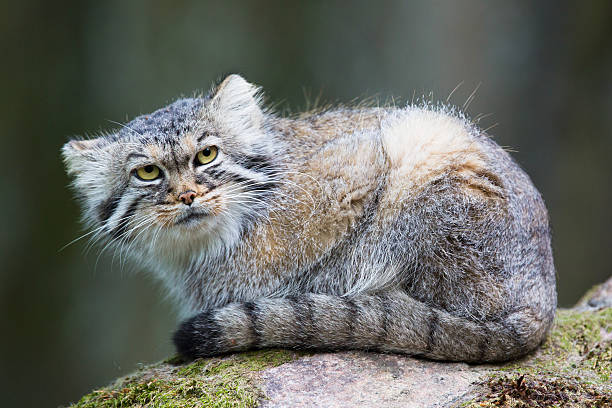ANIMAL: Pallas’s Cat Otocolobus manul Type of Animal: Feline Habitat: Mountains/mountainous areas, highlands, rocky areas, rocky outcrops, rocky slopes, ravines, steppe, mountain foothills, hills, hilly landscapes w/ low shrubs & xerophytic grasses, high plateaus w/ low shrubs & xerophytic grasses, intermontane valleys w/ low shrubs & xerophytic grasses, semi-desert/montane steppe transition areas, semi-desert, desert, shrubland, grassland, rocky high-elevation plains, alpine meadows, alpine pastures, snow-covered valleys of less than 3.94 in, open flatlands, caves, burrows, crevices, juniper forest ridges Location(s): Ranges from Caucasus through C Asia all the way to parts of Siberia Appearance: Smaller grayish stocky fluffy cat w/ rounded ears, sometimes fur has pale yellowish-ochre or pale yellowish-reddish hues. Summer coat darker-rich color while winter coat is grayer. Food/Diet: Rodents, lagomorphs, hedgehogs, shrews, birds, lizards, insects, carrion Status in Wild: Stable Conservation: Breeding in zoos & wildlife centers. Manul Working Group/Pallas Cat Working Group created in 2012 & Pallas Cat International Conservation Alliance (PICA) set up in 2016. Lifestyle: Solitary Additional Info: Called: Male: Tom Female: Queen Young: Kitten Group: Solitary Weight: Male: 6.48-11.02 lbs Female: 5.84-10.03 lbs Young: 1.1 lb Gestation: 2.5 months Life Span: 7-9 years Height: 0.98-1 ft, same for both sexes Body Length: 1.5-2 ft, same for both sexes Tail Length: 8.3-12.2 in, same for both sexes Main predators are snow leopards, wolves, dogs, foxes, eagles, & eagle owls. Also called the Manul. Named for Prussian/German zoologist Peter Pallas. Sexually mature at 5-6 months. When chased, these cats seek refuge rather than run due to them being poor runners. Though stable, they face threats such as habitat fragmentation/loss, mining, climate change, poaching for fur/sport/medicinal use, persecution, poisoning, livestock presence, disease, infrastructure developments, inbreeding, pet trade, & accidental capture. Litters range from 2-8 kittens & they stay w/ mom for 5-8 months. Breed from December-March w/ kittens being born in spring. Fur coloration aids in camouflage. Fun Fact(s): These cats can purr, growl, yelp, & hiss. Densest fur of any cat in the world. These cats rather difficult to breed in captivity. These cats appear on Russia’s two-ruble coin. Females only in heat for 1-2 days a year. They fluff themselves up to make themselves look bigger when threatened. These cats are very shy & secretive in wild & can be quite ferocious if cornered/bothered. Despite their fluffy appearance, they don’t make good pets.
